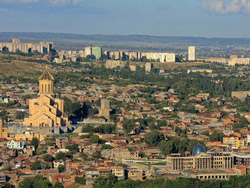Tbilisi, Georgia

Tbilisi is not just a very interesting city from a historical and cultural point of view, this city has something unique that is unique to it. There is a special atmosphere here, which is conveyed literally in everything: in small stone houses with red roofs, located on the slopes of the mountains, one higher than the other, in narrow crooked streets, in unusually friendly and hospitable people, in nature, which so generously bestowed its beauty this region. Even the name of the city speaks for itself - from the Georgian language “Tbili” is translated as “warm”. True, until 1936 the city was called Tiflis in Russian.
The modern name was given to the city because of its numerous warm sulfur springs, which for a long time served local residents as a place for bathing, and later developed into the baths for which Tbilisi is so famous. Tours to Georgia It’s impossible to imagine without visiting Tbilisi.
Location of Tbilisi
Tbilisi is located in the very center of the picturesque Shida Kartli province, near the Kura River. The area of the city is 348.6 km2
Climate
The climate here is mild continental. The average temperature in January is +3-9 C. Summer is hot and long - the average temperature in August varies from +23 C to +26 C.
Demographics of Tbilisi
Until the mid-20th century, the overwhelming majority of the city's population were Armenians and Azerbaijanis. According to the 1999 census, the city has a population of 1 million 345 thousand people. The population is increasing from year to year. Today, Tbilisi is inhabited by: Georgians - 80 %, Armenians - 7 %, Azerbaijanis - 7 %, Russians - 5 %, Ossetians - 3 %, Kurds - 2 % and Greeks - 2 %. The official language is Georgian, but Russian, Armenian and Azerbaijani are also widely spoken. The vast majority of the believing population profess Orthodox Christianity.
Industry
Tbilisi is the industrial center of the country. Mainly heavy and light industries are developed here: mechanical engineering, textile, food (especially winemaking), woodworking, glass, chemical, and printing industries.
Architecture of Tbilisi
The architecture of Tbilisi is unique; here you can find a rare combination of modern and ancient architecture in close proximity to each other. Near the temples of the 5th - 7th centuries. Modern multi-storey buildings, wide streets, parks, gardens and public gardens coexist harmoniously. In the southeastern part of the city is the historical center of Tbilisi, the Old Town. In old Tbilisi you can find architectural monuments of the 5th century, but for the most part buildings of the 19th century predominate here. Some of these architectural monuments are included in the UNESCO World Heritage Lists. Here you can admire the ruins of the citadel of the Narikala fortress, dating back to the 16th - 17th centuries, the ancient stone church of Anchiskhati, the Metekhi church, the Sioni Cathedral and the famous sulfur baths.

Story
Tbilisi is a city with a rich history, whose origins go back to ancient times. In sources and ancient chronicles, Tbilisi is mentioned back in the 4th century. However, the results of archaeological excavations indicate that the territory on which modern Tbilisi is located was inhabited back in the 4th millennium BC.